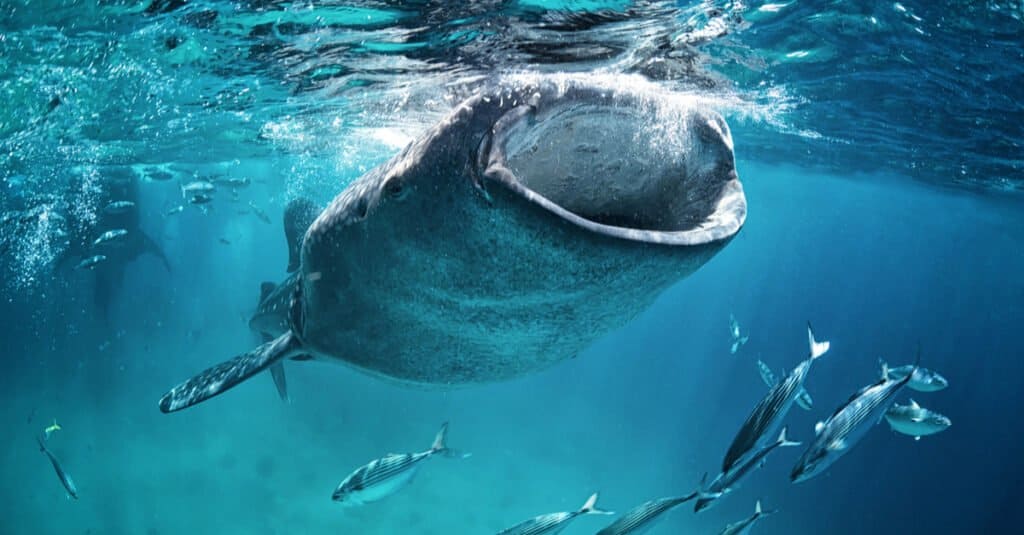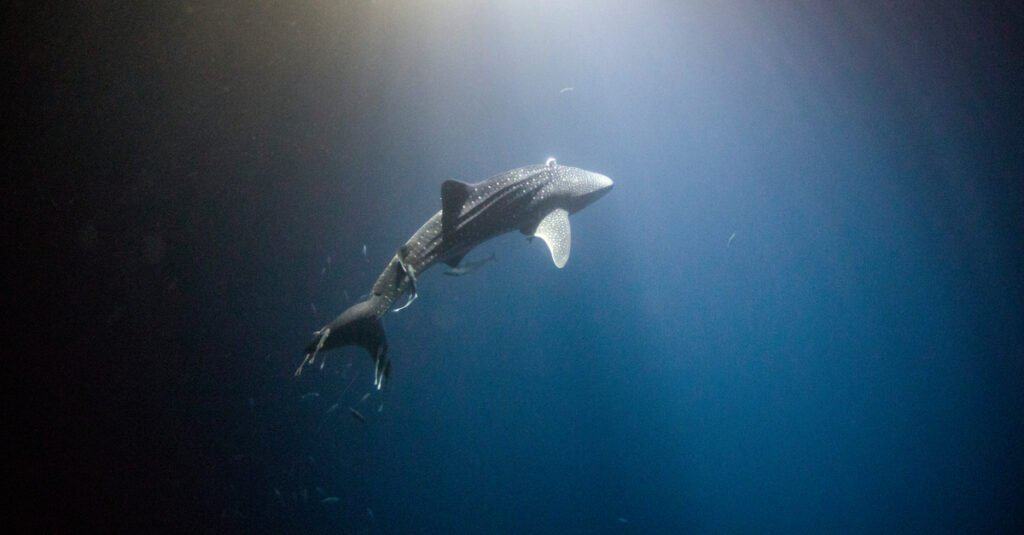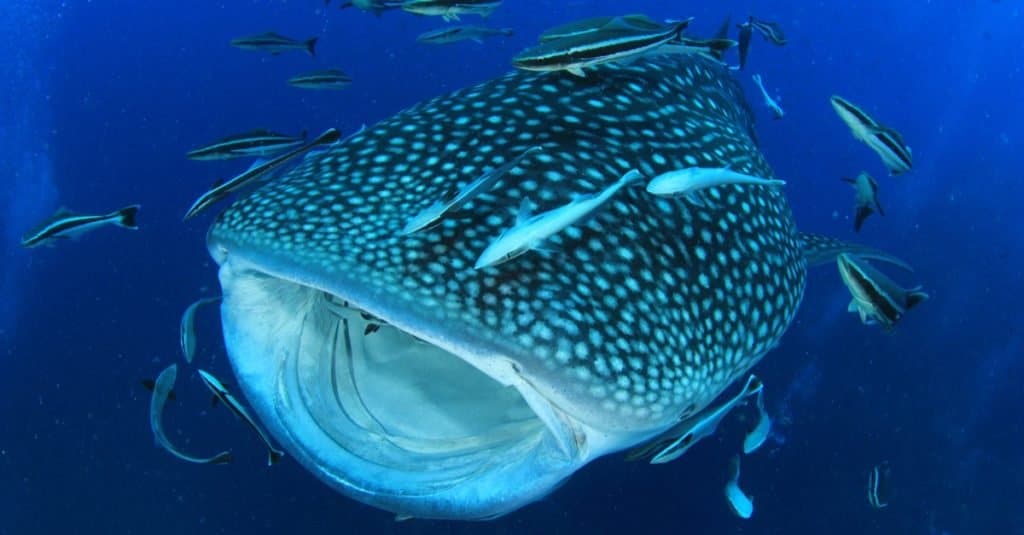Whale sharks are the largest living fish in the world. These massive animals are truly breathtaking and worthy of anyone’s interest and are found all over the oceans of the world. Seeing one of these fish is a reminder of the world under the water that exists, mostly unaware of humans. For many, the sheer size of whale sharks is reason enough to learn more about them. As the largest fish in our oceans today, how big can a whale shark really get?
How big are whale sharks?

Whale sharks are usually between 5.5 and 10 meters, but can grow larger.
©Fata Morgana by Andrew Marriott/Shutterstock.com
On average, whale sharks can grow between 5.5-10 meters, or between 18 and 33 feet. Although that is the average size, there have been a few instances where they exceeded that by nearly double.
Whale sharks were first distinguished as a species in 1828 after a small specimen was killed off the coast of Table Bay, South Africa. The man named it so because it was a fish that was as big as some species of whale. But just how big can they get?
Whale sharks are sexually dimorphic, meaning their males and females are two separate sizes. Males are considered fully mature around 8-9 meters (up to 30 feet). Females are generally larger, but a small sample size has made estimation difficult. One study showed that females reach around 14.5 meters (48 feet) on average, nearly doubling that of males.
When it comes to weight, exact numbers are difficult. Since they are so large, pulling one to shore is nearly impossible, and most boats can’t weigh them accurately. For an average 12 meter long shark, it’s likely they weigh around 15 tons. To put that in perspective, it would take five Honda Accords stacked up to equal the average weight of a single whale shark.
What is the biggest whale shark ever discovered?

The largest whale shark ever recorded was 18.8 meters long.
©Lindsey Lu/Shutterstock.com
The largest whale shark on record reached 61.7 feet (or 18.8 meters) in length.
There have been many reports over the years of record whale sharks, but not all of these may be true. The record of 61.7 feet long is thought to be reliable as it was measured during a study on marine megafauna. While that may be the largest on record, it certainly isn’t the largest in legend. Even without these chart-topping winners, it’s likely that whale sharks aren’t just the largest fish on earth but the largest fish to ever live.
Potential other largest whale sharks of all time
In 1868 an Irish scientist went on an expedition to Seychelles to study the fish and claims to have seen two large specimens – one that was over 15 meters and another that was 23 meters (75 feet). While there isn’t any official documentation for these, the second would hold the record for being the largest ever seen.
In 1995, a 20.75-meter (68 feet) shark was stranded on the coast of Ratnagiri. Although it was stranded near a large Indian city, the size was difficult to determine accurately.
How can whale sharks grow so big?

Whale sharks
can eat up to 45 pounds of food a day to fuel their massive bodies.
©weera bunnak/Shutterstock.com
Whale sharks have a few advantages that allow them to grow so large. Let’s look at some of them.
The first and most obvious is that they have no known natural predators. When whale sharks are born, they measure a measly 21-25 inches, making them easy prey for other larger fish. As they grow, however, the shark soon outpaces all its peers and becomes an ocean giant. Within a few years, there aren’t any predators that would want to tussle with one based on its bulk alone. With predation out of the picture, growing to maximum size isn’t all too hard.
While they can reach sexual maturity (and average size) by 25 years, that is still far from their top-end of life. More data is needed to be certain, but scientists believe that many who make it through the tough states of early life live to be well over 100 years old. They grow rather fast but slow as they mature. With such a long life, it’s no wonder that these fish can grow to be so massive.
Diet
The diet of whale sharks surely contributes to their size. Whale sharks are filter feeders, one of only three filter-feeder shark species known. In fact, the second largest shark in the world and blue whales are also filter-feeders, so you can see how this diet can contribute to the massive size of the largest sea creatures.
Filter feeders don’t actively “hunt” their food; rather, they gulp down large portions of water as they swim and let their bodies sort through it. When they see large concentrations of their favorite foods (plankton, krill, fish eggs, and larvae), they will ram through it and gulp as much water as they can.
Because small ocean life is the most numerous in volume, it isn’t hard for these slow movers to hunt. In fact, a juvenile whale shark can easily eat 45 pounds of food a day. When you weigh 15 tons, it’s important that you get your nutrients!
Where do whale sharks live?

Whale sharks live
in all temperate and tropical waters of the world.
©Rich Carey/Shutterstock.com
Whale sharks are surprisingly well-dispersed through nearly all the world’s oceans. Currently, they live in all tropical waters and moderately temperate seas. It feeds in coastal habitats, as well as deep ocean ones, making spotting one in the wild possible. Through the year, they migrate to follow food and warm water temperatures.
There are two major populations. The largest is an Indo-Pacific subpopulation that has 75% of the entire population, but a second smaller population lives from Main to the southern tip of Africa. The migratory pattern of the fish reflects their desire to stay where the water is warmer than 70 degrees, but they can be spotted outside of that range occasionally.
The smallest known whale shark
The smallest known whale shark was found at the beach in Pilar, Sorsogon, Philippines, in 2009. The small fish was tied to a stake by its tail and was only 15 inches long. The discovery prompted scientists to view the region as more than just a feeding ground but a birthing region as well.
The photo featured at the top of this post is © paul cowell/Shutterstock.com
Thank you for reading! Have some feedback for us? Contact the AZ Animals editorial team.







